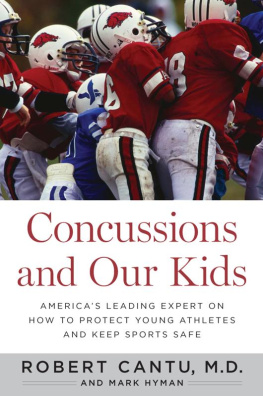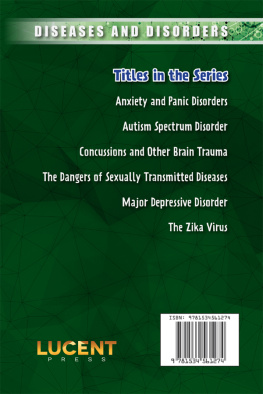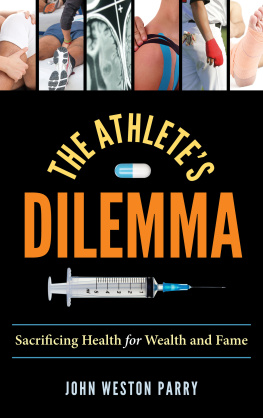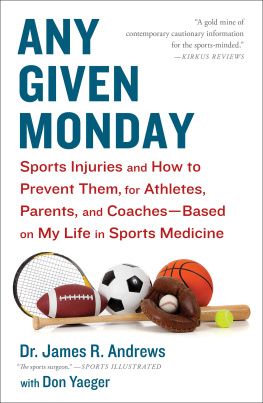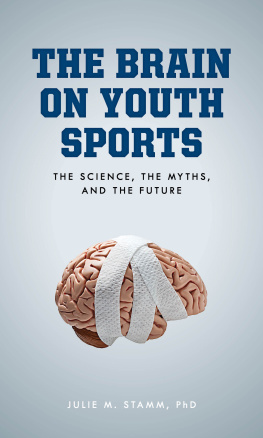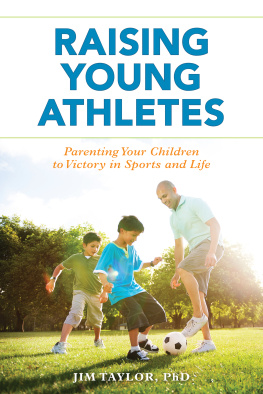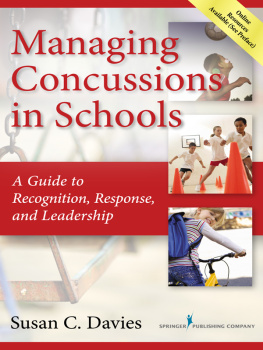Copyright 2012 by Robert Cantu and Mark Hyman
All rights reserved
For information about permission to reproduce selections from this book, write to Permissions, Houghton Mifflin Harcourt Publishing Company, 215 Park Avenue South, New York, New York 10003.
www.hmhbooks.com
The Library of Congress has cataloged the print edition as follows:
Cantu, Robert C.
Concussions and our kids : Americas leading expert on how to protect young athletes and keep sports safe / Robert Cantu and Mark Hyman.
p. ; cm.
Includes index.
ISBN 978-0-547-77394-0
I. Hyman, Mark. II. Title.
[ DNLM : 1. Brain Concussion. 2. Adolescent. 3. Athletes. 4. Athletic Injuries prevention & control. 5. Child. wl 354]
617.1'027083dc23 2012014029
All illustrations by Greg Maxson Illustration
eISBN 978-0-547-77403-9
v1.0912
PHOTO CREDITS : , Deborah Chapman.
THIS BOOK IS NOT INTENDED TO BE A SUBSTITUTE FOR CONSULTATION WITH A PROFESSIONAL HEALTHCARE PROVIDER. THE PUBLISHER AND THE AUTHORS DISCLAIM RESPONSIBILITY FOR ANY ADVERSE EFFECTS RESULTING DIRECTLY OR INDIRECTLY FROM INFORMATION CONTAINED IN THIS BOOK.
To the many young men and women who fill my waiting room coping with drastically altered lifes routines and often shattered dreams because of post-concussion symptoms. And to the wind beneath my wings, my wife, Tina.
R.C.
To Peggy, for everything.
M.H.
1. What Is a Concussion?
We need to do something now, this minute. Too many kids are at risk.
D R . A NN M CKEE (Time)
We still have this culture where its hard to convince people that a concussion is a very serious brain injury.
D AWN C OMSTOCK , principal investigator, Center for Injury Research and Policy, The Research Institute, Nationwide Childrens Hospital, Ohio State University (Time)
I N THE LATE 1950s, I was a student at Cal-Berkeley and a member of Cals baseball team. We were playing Stanford one afternoon, and I came to bat. This was the dark ages before batters wore helmets with ear flaps. Our protectionif you can call it thatwas a flimsy liner inside our felt caps.
A pitch came inside and tight, and I didnt react as quickly as I needed to. The ball caught me flush on the side of the head. The cap and the hard liner were just about worthless. The force of the blow stunned me, and I wobbled a bit as I made my way down the line to first base. This didnt seem to bother anyone as much as the blood trickling from my ear. It wasnt really coming from my earthe force of the pitch had shattered the cap liner, which sliced into my scalp.
The coaches didnt know that, of course. They took one look at me and thought, My God, Cantu has a skull fracture! Get him to the hospital!
In those days, it wouldnt have occurred to anyone in either dugout that I might have had a concussion. Even at the hospital it wasnt diagnosed. Its only looking back with years of experience in this field that I can saybased on my symptoms, which included not knowing where I was for a while, lightheadedness, and a violent headachethat I certainly had a concussion.
Weve come a long way since those unenlightened times. Now head trauma in sports is a topic that leads nightly newscasts and is debated at every level of amateur and professional sports. I knew that concussions had become something of a national obsession when Jerry Seinfeld built an entire monologue around the question Why did we invent the helmet? Normally, there isnt a lot of humor associated with head trauma of any kind, but Seinfelds take is amusing. First, he says, we invented sports, the main feature of which is slamming our heads into each other over and over. Then, We chose not to avoid these activities but to make little plastic hats so we could continue our head-cracking lifestyles.
A Concussion Is...
The word derives from the Latin concutere for to shake violently. Concussions are just thata shaking of the brain inside the skull that changes the alertness of the injured person. That change can be relatively mild. (She is slightly dazed.) It can be profound. (She falls unconscious.) Both fall within the definition.
According to the Centers for Disease Control and Prevention, almost four million sports- and recreation-related concussions are recognized every year, with many times that number occurring but going unrecognized. For young people ages fifteen to twenty-four years, sports are the second leading cause of traumatic brain injury behind only motor vehicle crashes. According to research by the New York Times, at least fifty youth football players (high school or younger) from twenty different states have died or sustained serious head injuries on the field since 1997. One study estimates that the likelihood of an athlete in a contact sport experiencing a recognized concussion is as high as 20 percent each season. In my office, there is a very discernible cycle in the number of concussion patients. In the fall (football season) and winter (ice hockey) the numbers go up, sometimes exceeding fifteen new young athletes with a concussion per week. In the spring and summer, they slide back down.
How They Happen
Concussions happen to all types of athletesyoung and old, boys and girls, and in every conceivable sport. In a typical year, I see hundreds of children and adolescents in my office. We see more than athletes, of course. Some patients have suffered concussions in traffic accidents, mishaps around the house (they walked into a door), or a slip and fall in the grocery store.
In a chapter later in this book, I offer observations about concussions in non-collision sports such as volleyball and tennis that parentsfor good reasondo not think of as posing a great risk of concussion. However, there is risk in every sport. I would have to think a long time before naming one that has not sent a single patient to our office at Emerson Hospital in Concord, Massachusetts.
Many patients get well over two to three weeks, pretty much as expected. Other cases take unexpected turns. Mario was an eleven-year-old kid making one of those typical recoveries. After his concussion, he had a number of symptoms. We held him back from sports, gym, and physical activity. He was also under restrictions regarding his schoolwork. Just as he was about ready to resume normal activity, Mario hit his head on a bedpost and suffered another concussion. The process started all over again. I cant count the number of stories like that. Unfortunately, they happen a lot.
Concussions in sports occur when an athlete is slammed and makes sudden and forceful contact. That contact can be with the ground, court, or pool deck. It also can be with a batted ball, a thrown ball, a kicked ball, a goalpost (football), the boards (hockey), the scorers table (basketball), and of course another player. Dylan Mello, a high school soccer and ice hockey player from Rhode Island, suffered a severe concussion in a collision with a player who smashed him with the plaster cast on his arm.
Concussions can and frequently do occur without any contact with the head. Rather, the players body receives a jolt that causes his shoulders and head to change speed or direction violently. Its the whiplash effect. Inside the skull, the brain shifts in the cerebrospinal fluid and bangs against the inside of the skull. Even falling from five or six feet and landing upright, if its unexpected, and therefore jarring, can send a shock through the spine and shake the head with a force that may cause a concussion. Concussions that are the most damaging to the brain tend to be the ones that involve a direct blow to the head, however. When youre struck in the head, the forces generated are about fifty times greater than being struck in another part of the body.
With such a blow, the brain pushes forward until it crashes into the skull, reverses, and bumps against the back of the skull.
Next page
